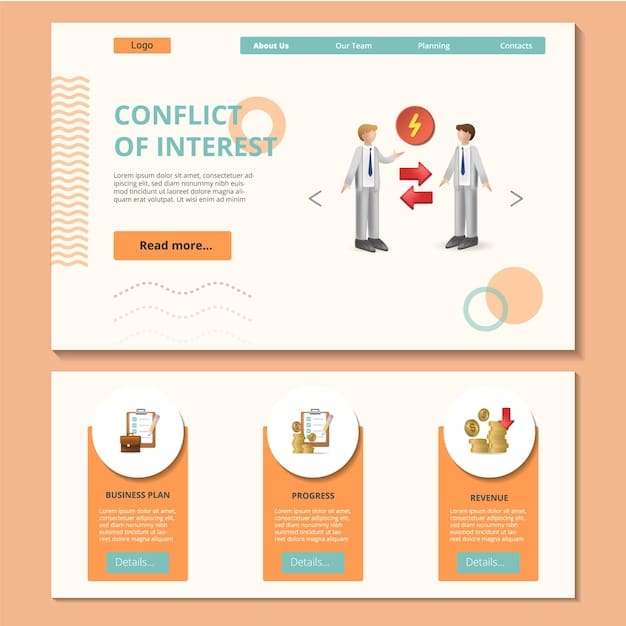Reduce Chargebacks: A Step-by-Step Guide for US E-commerce

Discover actionable strategies to reduce chargebacks by 15% in just 3 months with our comprehensive guide, tailored specifically for US e-commerce businesses navigating payment dispute resolution.
Is your US e-commerce business struggling with chargebacks? High chargeback rates can lead to increased fees, penalties, and even the loss of your merchant account. This step-by-step guide provides the strategies and tactics you need to reduce chargebacks by 15% in 3 months: a comprehensive guide to payment dispute resolution for US e-commerce businesses.
Understanding the Chargeback Landscape for US E-commerce
Chargebacks are a significant challenge for e-commerce businesses, representing lost revenue and increased operational costs. In the US, understanding the specific reasons behind chargebacks is crucial for effective prevention and resolution.
First, let’s define what a chargeback really is.
What is a Chargeback?
A chargeback occurs when a customer disputes a transaction with their bank or credit card issuer. The bank then withdraws the disputed amount from the merchant’s account, initiating a formal dispute process. Understanding the reasons behind these chargebacks is the first step in mitigating them.
There are several reasons why customers might initiate a chargeback.
Common Reasons for Chargebacks
Understanding these reasons will help you to focus in on where to improve your practices.
- Customer disputes: The customer doesn’t recognize the transaction or claims they didn’t authorize it.
- Fraudulent transactions: Unauthorized use of a customer’s credit card.
- Product or service issues: Dissatisfaction with the quality, delivery, or description of the product or service.
- Processing errors: Mistakes made during the transaction process, such as incorrect amounts or duplicate charges.
By understanding these common reasons, you can tailor your approach to preventing and resolving chargebacks.

Step-by-Step Guide to Reducing Chargebacks
Reducing chargebacks requires a proactive and multi-faceted approach, focusing on prevention, detection, and effective dispute resolution. This step-by-step guide provides actionable strategies that US e-commerce businesses can implement to mitigate chargebacks.
The first step is to prevent them happening in the first place.
Prevention Strategies
Preventative measures are the most effective way to reduce chargebacks. By implementing robust security protocols and customer service practices, you can minimize the likelihood of disputes.
- Implement strong authentication measures: Use tools like Address Verification System (AVS) and Card Verification Value (CVV) to verify customer information.
- Provide clear product or service descriptions: Ensure your website accurately describes what customers are purchasing.
- Offer excellent customer service: Promptly address customer inquiries and resolve issues before they escalate into chargebacks.
- Use order confirmation emails and shipping notifications: Keep customers informed about their orders and shipping status.
It’s also important to identify chargebacks as soon as possible.
Early Detection Tactics
Early detection of potentially fraudulent or disputed transactions is crucial for preventing chargebacks. Implementing monitoring systems and risk assessment tools can help you identify suspicious activities and take immediate action.
- Monitor transaction patterns: Look for unusual spikes in transaction volume or suspicious order patterns.
- Use fraud detection tools: Employ fraud scoring and risk assessment systems to identify high-risk transactions.
- Set up alerts for suspicious activity: Receive real-time notifications for potentially fraudulent transactions.
If a chargeback does occur, it’s important to respond quickly and effectively.
Effective Dispute Resolution
When a chargeback occurs, the way you respond can significantly impact the outcome. Effective dispute resolution involves gathering compelling evidence, presenting a strong case, and adhering to the specific requirements of the card networks.
Collecting the right evidence is essential.
Gathering Compelling Evidence
The strength of your chargeback response depends on the quality of the evidence you provide. Gather all relevant documentation to support your case and demonstrate the validity of the transaction.
Here are some common examples of evidence that may be relevant to your dispute:
- Transaction records: Include transaction receipts, order confirmations, and payment details.
- Shipping and delivery confirmations: Provide proof of shipment, tracking information, and delivery confirmations.
- Customer communications: Submit emails, chat logs, and other communications with the customer.
- Terms and conditions: Include your website’s terms and conditions, which outline the refund and return policies.
This evidence must be compiled into a clear and concise presentation.
Presenting a Strong Case
A well-organized and persuasive chargeback response can significantly increase your chances of winning the dispute. Present your evidence in a clear and logical manner, highlighting key points that support your case.
Bear in mind the following:
- Clearly state the reason for the chargeback and provide a concise explanation of why it is invalid.
- Organize your evidence in a logical sequence, making it easy for the reviewer to understand your case.
- Focus on the key facts and avoid irrelevant information.
It’s also vital you’re aware of the specific requirements.
Understanding Card Network Requirements
Each card network (Visa, Mastercard, American Express, etc.) has specific requirements and procedures for chargeback disputes. Understanding these rules is essential for crafting a successful response and maximizing your chances of winning the dispute.
These are the key areas to focus on.
Visa Chargeback Requirements
Visa has specific guidelines for different types of chargebacks, including fraud, authorization issues, and service-related disputes. Familiarize yourself with Visa’s chargeback reason codes and documentation requirements to ensure compliance.
Key considerations for Visa chargebacks:
- Understand Visa’s chargeback reason codes and documentation requirements.
- Ensure your response meets Visa’s deadlines and formatting guidelines.
Mastercard also have their own rules to follow.
Mastercard Chargeback Requirements
Mastercard also has its own unique chargeback rules and procedures. Understanding Mastercard’s requirements is crucial for effectively disputing chargebacks processed through the Mastercard network.
Keep this in mind for Mastercard:
- Check the latest Mastercard chargeback guidelines for updates and changes.
- Provide all required documentation in the specified format.
The same also applies to American Express.
American Express Chargeback Requirements
American Express has its own set of rules and procedures for chargeback disputes. Understanding these requirements is essential for effectively disputing chargebacks processed through the American Express network.
Important steps for American Express:
- Follow American Express’s specific documentation and submission guidelines.
- Respond to chargebacks within the specified time frame.
Adapting your approach for each card network will make your dispute resolution process much more efficient and effective.

Tracking and Analyzing Chargeback Data, adapt and optimize
Effective chargeback management involves continuous monitoring and analysis of chargeback data. By tracking key metrics and identifying trends, you can gain valuable insights into the root causes of chargebacks and focus your efforts on the most impactful prevention strategies.
It’s important to track your key indicators.
Key Metrics to Track
Monitoring these metrics will provide insight into your chargeback situation. It’s crucial to track key indicators to assess the effectiveness of your chargeback management efforts.
- Chargeback rate: The percentage of transactions that result in chargebacks.
- Reason codes: The specific reasons cited by customers for initiating chargebacks.
- Disputed amounts: The total value of transactions disputed by customers.
The data from these metrics can be used to adapt your approach.
Using Data to Adapt
Use the data gathered to make adjustments to your approach, and resolve any existing problems. By analyzing these insights, you can identify areas for improvement and implement targeted strategies to reduce chargebacks.
Focus on these factors:
- Identify the most common reasons for chargebacks and address the underlying issues.
- Evaluate the effectiveness of your fraud prevention measures and make necessary adjustments.
- Continuously monitor your chargeback rate and track the impact of your interventions.
By monitoring and adapting, you’ll consistently improve over time.
Staying Compliant with Regulations
E-commerce businesses must comply with various regulations related to payment processing and chargeback disputes. Staying informed about these regulations and ensuring compliance is essential for avoiding penalties and maintaining a positive reputation.
The first step is understanding your obligations.
Understanding PCI DSS Compliance
The Payment Card Industry Data Security Standard (PCI DSS) is a set of security standards designed to protect cardholder data. E-commerce businesses that accept credit card payments must comply with PCI DSS requirements to ensure the security of sensitive information.
Here’s what you need to know about PCI DSS Compliance:
- Implement and maintain a secure network infrastructure.
- Protect cardholder data by encrypting transmissions and storing data securely.
- Regularly monitor and test your security systems.
You also need to be aware of consumer protection laws.
Consumer Protection Laws
Consumer protection laws, such as the Fair Credit Billing Act (FCBA), provide consumers with certain rights related to billing errors and unauthorized charges. E-commerce businesses must be aware of these laws and comply with their requirements.
Here’s what you need to know about Consumer Protection Laws:
- Provide clear and accurate billing statements to customers.
- Promptly investigate and resolve billing errors and unauthorized charges.
- Comply with disclosure requirements related to refund and return policies.
Following these laws will protect your customers, and your business.
| Key Point | Brief Description |
|---|---|
| 🛡️ Prevention Strategies | Implement robust security measures like AVS and CVV verification. |
| 🔎 Early Detection Tactics | Monitor transaction patterns and use fraud detection tools. |
| 💼 Dispute Resolution | Gather compelling evidence for effective chargeback responses. |
| 📊 Data Analysis | Continuously analyze chargeback data to refine prevention strategies. |
Frequently Asked Questions
▼
A chargeback is a refund requested by a customer from their bank or credit card issuer, often due to fraud, dissatisfaction, or billing errors. They happen when customers dispute a transaction and the bank withdraws the funds from the merchant’s account to investigate.
▼
Preventing chargebacks involves several strategies, including using strong authentication methods, providing excellent customer service, clearly describing products, and keeping customers informed about their orders. Aim to resolve issues before they escalate into chargebacks.
▼
When disputing a chargeback, gather transaction records, shipping confirmations, customer communication logs, and your store’s terms and conditions. The more comprehensive the evidence, the stronger your case will be.
▼
Each card network (Visa, Mastercard, etc.) has specific rules for disputes. Make sure your response complies with their individual formatting and deadline requirements. Stay updated with their latest guidelines to ensure compliance.
▼
Tracking key metrics like chargeback rates and reason codes helps you understand the root causes of chargebacks. Analyzing this data lets you refine fraud prevention measures, and make data-driven decisions, leading to significant chargeback reduction.
Conclusion
By implementing these strategies, US e-commerce businesses can significantly reduce chargeback rates and protect their revenue. Reducing chargebacks by 15% in 3 months: a comprehensive guide to payment dispute resolution for US e-commerce businesses is achievable with a proactive, data-driven approach, combining robust prevention measures with effective dispute resolution tactics. Continuous monitoring, adaptation, and compliance with regulations are essential for long-term success.





